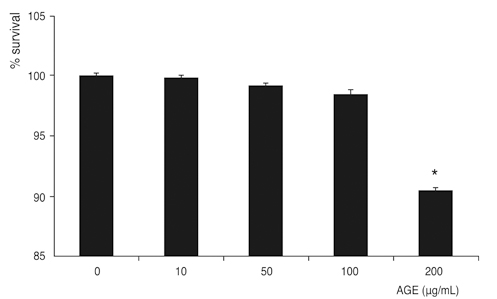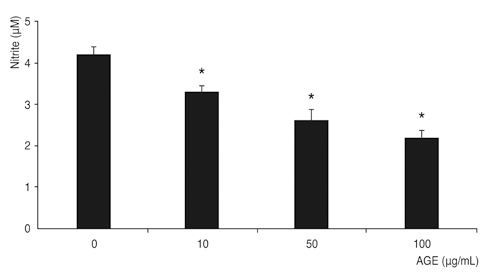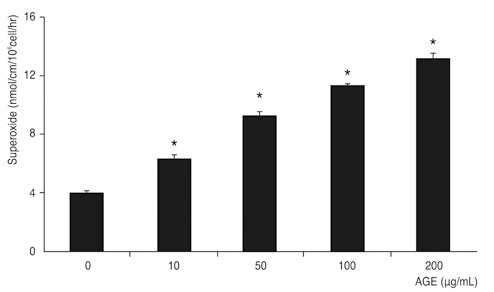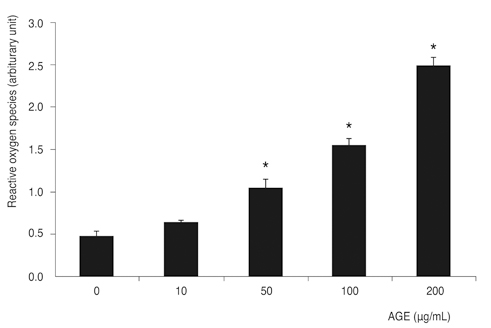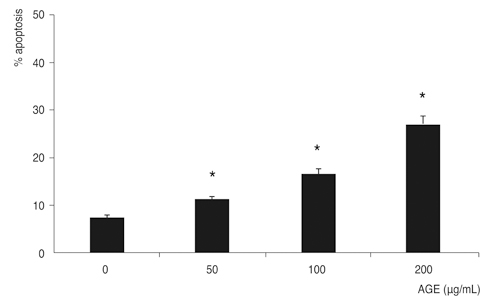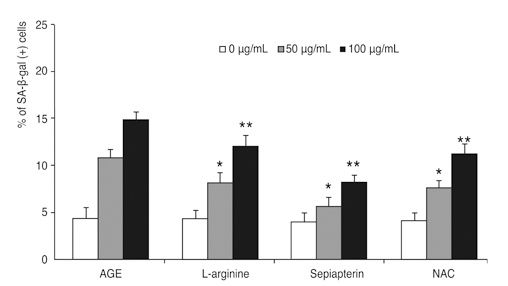Korean J Ophthalmol.
2012 Apr;26(2):123-131. 10.3341/kjo.2012.26.2.123.
Effect of Advanced Glycation End Products on Oxidative Stress and Senescence of Trabecular Meshwork Cells
- Affiliations
-
- 1Department of Ophthalmology, Catholic University of Daegu School of Medicine, Daegu, Korea. jwkim@cu.ac.kr
- KMID: 1364866
- DOI: http://doi.org/10.3341/kjo.2012.26.2.123
Abstract
- PURPOSE
To investigate the effect of advanced glycation end products (AGE) on oxidative stress and cellular senescence in cultured human trabecular meshwork cells (HTMC).
METHODS
Primarily cultured HTMC were exposed to 0, 10, 50, 100, 200 microg/mL of glycated bovine serum albumin (G-BSA) for 5 days. Also co-exposed were L-arginine, sepiapterin, and antioxidant N-acetylcysteine (NAC). Cellular survival and production of nitric oxide (NO), superoxide, and reactive oxygen species were assessed by 3-[4, 5-dimethylthiazol-2-yl]-2, 5-diphenyltetrazolium bromide assay, Griess assay, cytochrome c assay, and dichlorofluorescin diacetate assay, respectively. Senescence-associated beta-galactosidase staining was performed to quantify the degree of cellular senescence.
RESULTS
G-BSA decreased cellular survival, NO production, and increased superoxide production significantly in a dose-dependent manner. The effects of G-BSA were abolished with co-exposure of L-arginine, sepiapterin, and NAC. G-BSA enhanced cellular senescence accompanied by increased production of reactive oxygen species. G-BSA-induced cellular senescence was suppressed by application of L-arginine, sepiapterin, and NAC.
CONCLUSIONS
AGE enhances cellular senescence of HTMC accompanied with increased oxidative stress. AGE-induced oxidative stress and cellular senescence could be delayed by application of anti-oxidants.
Keyword
MeSH Terms
-
Acetylcysteine/metabolism
Apoptosis/drug effects/physiology
Arginine/metabolism
Cell Aging/drug effects/*physiology
Cell Survival/drug effects/physiology
Cells, Cultured
Glycosylation End Products, Advanced/metabolism/*toxicity
Humans
Nitric Oxide/metabolism
Oxidative Stress/*physiology
Pterins/metabolism
Reactive Oxygen Species/metabolism
Serum Albumin, Bovine/metabolism/toxicity
Trabecular Meshwork/drug effects/*metabolism/*pathology
Figure
Cited by 1 articles
-
Effect of Chronic Benzalkonium Chloride Exposure on Senescence in Trabecular Meshwork Cells
Jihae Park, Soo Jin Lee, Kyoo Won Lee, Jae Chan Kim
J Korean Ophthalmol Soc. 2019;60(1):55-61. doi: 10.3341/jkos.2019.60.1.55.
Reference
-
1. Alvarado J, Murphy C, Juster R. Trabecular meshwork cellularity in primary open-angle glaucoma and nonglaucomatous normals. Ophthalmology. 1984. 91:564–579.2. Rohen JW, Lutjen-Drecoll E, Flugel C, et al. Ultrastructure of the trabecular meshwork in untreated cases of primary open-angle glaucoma (POAG). Exp Eye Res. 1993. 56:683–692.3. Moncada S, Palmer RM, Higgs EA. Nitric oxide: physiology, pathophysiology, and pharmacology. Pharmacol Rev. 1991. 43:109–142.4. Bredt DS, Snyder SH. Nitric oxide: a physiologic messenger molecule. Annu Rev Biochem. 1994. 63:175–195.5. Brune B, von Knethen A, Sandau KB. Nitric oxide and its role in apoptosis. Eur J Pharmacol. 1998. 351:261–272.6. Schuman JS, Erickson K, Nathanson JA. Nitrovasodilator effects on intraocular pressure and outflow facility in monkeys. Exp Eye Res. 1994. 58:99–105.7. Wang RF, Podos SM. Effect of the topical application of nitroglycerin on intraocular pressure in normal and glaucomatous monkeys. Exp Eye Res. 1995. 60:337–339.8. Nathanson JA, McKee M. Alterations of ocular nitric oxide synthase in human glaucoma. Invest Ophthalmol Vis Sci. 1995. 36:1774–1784.9. Matsuo T. Basal nitric oxide production is enhanced by hydraulic pressure in cultured human trabecular cells. Br J Ophthalmol. 2000. 84:631–635.10. Eiserich JP, Patel RP, O'Donnell VB. Pathophysiology of nitric oxide and related species: free radical reactions and modification of biomolecules. Mol Aspects Med. 1998. 19:221–357.11. Boger RH. When the endothelium cannot say 'NO' anymore. ADMA, an endogenous inhibitor of NO synthase, promotes cardiovascular disease. Eur Heart J. 2003. 24:1901–1902.12. Yu BP, Yang R. Kitani K, Goto S, Aoba A, editors. Critical evaluation of the free radical theory of aging: a proposal for the oxidative stress hypothesis. Pharmacological intervention in aging and age-associated disorders. 1996. New York: New York Academy of Sciences;1–11.13. Bucala R, Vlassara H, Cerami A. Harding JJ, Crabbe MJ, editors. Advanced glycosylation end products. Post-translational modifications of proteins. 1992. Boca Raton: CRC Press;53–59.14. Bucala R, Tracey KJ, Cerami A. Advanced glycosylation products quench nitric oxide and mediate defective endothelium-dependent vasodilatation in experimental diabetes. J Clin Invest. 1991. 87:432–438.15. Franke S, Dawczynski J, Strobel J, et al. Increased levels of advanced glycation end products in human cataractous lenses. J Cataract Refract Surg. 2003. 29:998–1004.16. Nakamura N, Hasegawa G, Obayashi H, et al. Increased concentration of pentosidine, an advanced glycation end product, and interleukin-6 in the vitreous of patients with proliferative diabetic retinopathy. Diabetes Res Clin Pract. 2003. 61:93–101.17. Kaji Y, Usui T, Oshika T, et al. Advanced glycation end products in diabetic corneas. Invest Ophthalmol Vis Sci. 2000. 41:362–368.18. Schlotzer-Schrehardt U. Oxidative stress and pseudoexfoliation glaucoma. Klin Monbl Augenheilkd. 2010. 227:108–113.19. Davies PD, Duncan G, Pynsent PB, et al. Aqueous humour glucose concentration in cataract patients and its effect on the lens. Exp Eye Res. 1984. 39:605–609.20. Tan GS, Wong TY, Fong CW, et al. Diabetes, metabolic abnormalities, and glaucoma. Arch Ophthalmol. 2009. 127:1354–1361.21. Stitt AW. The maillard reaction in eye diseases. Ann N Y Acad Sci. 2005. 1043:582–597.22. Nathanson JA, McKee M. Identification of an extensive system of nitric oxide-producing cells in the ciliary muscle and outflow pathway of the human eye. Invest Ophthalmol Vis Sci. 1995. 36:1765–1773.23. Meyer P, Champion C, Schlotzer-Schrehardt U, et al. Localization of nitric oxide synthase isoforms in porcine ocular tissues. Curr Eye Res. 1999. 18:375–380.24. Weinreb RN, Bloom E, Baxter JD, et al. Detection of glucocorticoid receptors in cultured human trabecular cells. Invest Ophthalmol Vis Sci. 1981. 21:403–407.25. Valencia JV, Weldon SC, Quinn D, et al. Advanced glycation end product ligands for the receptor for advanced glycation end products: biochemical characterization and formation kinetics. Anal Biochem. 2004. 324:68–78.26. Bradford MM. A rapid and sensitive method for the quantitation of microgram quantities of protein utilizing the principle of protein-dye binding. Anal Biochem. 1976. 72:248–254.27. Mosmann T. Rapid colorimetric assay for cellular growth and survival: application to proliferation and cytotoxicity assays. J Immunol Methods. 1983. 65:55–63.28. Green LC, Wagner DA, Glogowski J, et al. Analysis of nitrate, nitrite, and [15N]nitrate in biological fluids. Anal Biochem. 1982. 126:131–138.29. Beauchamp C, Fridovich I. Superoxide dismutase: improved assays and an assay applicable to acrylamide gels. Anal Biochem. 1971. 44:276–287.30. Teufelhofer O, Weiss RM, Parzefall W, et al. Promyelocytic HL60 cells express NADPH oxidase and are excellent targets in a rapid spectrophotometric microplate assay for extracellular superoxide. Toxicol Sci. 2003. 76:376–383.31. Wang H, Joseph JA. Quantifying cellular oxidative stress by dichlorofluorescein assay using microplate reader. Free Radic Biol Med. 1999. 27:612–616.32. Vermes I, Haanen C, Steffens-Nakken H, Reutelingsperger C. A novel assay for apoptosis. Flow cytometric detection of phosphatidylserine expression on early apoptotic cells using fluorescein labelled Annexin V. J Immunol Methods. 1995. 184:39–51.33. Dimri GP, Lee X, Basile G, et al. A biomarker that identifies senescent human cells in culture and in aging skin in vivo. Proc Natl Acad Sci U S A. 1995. 92:9363–9367.34. Van der Loo B, Fenton MJ, Erusalimsky JD. Cytochemical detection of a senescence-associated beta-galactosidase in endothelial and smooth muscle cells from human and rabbit blood vessels. Exp Cell Res. 1998. 241:309–315.35. Polansky JR, Weinreb RN, Baxter JD, Alvarado J. Human trabecular cells. I. Establishment in tissue culture and growth characteristics. Invest Ophthalmol Vis Sci. 1979. 18:1043–1049.36. Alvarado JA, Wood I, Polansky JR. Human trabecular cells. II. Growth pattern and ultrastructural characteristics. Invest Ophthalmol Vis Sci. 1982. 23:464–478.37. Schmidt AM, Hori O, Brett J, et al. Cellular receptors for advanced glycation end products. Implications for induction of oxidant stress and cellular dysfunction in the pathogenesis of vascular lesions. Arterioscler Thromb. 1994. 14:1521–1528.38. Ramasamy R, Vannucci SJ, Yan SS, et al. Advanced glycation end products and RAGE: a common thread in aging, diabetes, neurodegeneration, and inflammation. Glycobiology. 2005. 15:16R–28R.39. Stitt AW, Moore JE, Sharkey JA, et al. Advanced glycation end products in vitreous: Structural and functional implications for diabetic vitreopathy. Invest Ophthalmol Vis Sci. 1998. 39:2517–2523.40. Stitt AW. Advanced glycation: an important pathological event in diabetic and age related ocular disease. Br J Ophthalmol. 2001. 85:746–753.41. Stitt AW. The role of advanced glycation in the pathogenesis of diabetic retinopathy. Exp Mol Pathol. 2003. 75:95–108.42. Kaji Y, Amano S, Usui T, et al. Expression and function of receptors for advanced glycation end products in bovine corneal endothelial cells. Invest Ophthalmol Vis Sci. 2003. 44:521–528.43. Pokupec R, Kalauz M, Turk N, Turk Z. Advanced glycation endproducts in human diabetic and non-diabetic cataractous lenses. Graefes Arch Clin Exp Ophthalmol. 2003. 241:378–384.44. Amano S, Kaji Y, Oshika T, et al. Advanced glycation end products in human optic nerve head. Br J Ophthalmol. 2001. 85:52–55.45. Grierson I, Howes RC. Age-related depletion of the cell population in the human trabecular meshwork. Eye (Lond). 1987. 1(Pt 2):204–210.46. Alvarado J, Murphy C, Juster R. Trabecular meshwork cellularity in primary open-angle glaucoma and nonglaucomatous normals. Ophthalmology. 1984. 91:564–579.47. Millard CB, Tripathi BJ, Tripathi RC. Age-related changes in protein profiles of the normal human trabecular meshwork. Exp Eye Res. 1987. 45:623–631.48. Schachtschabel DO, Binninger E. Aging of trabecular meshwork cells of the human eye in vitro. Z Gerontol. 1990. 23:133–135.49. Horstmann HJ, Rohen JW, Sames K. Age-related changes in the composition of proteins in the trabecular meshwork of the human eye. Mech Ageing Dev. 1983. 21:121–136.50. Alp NJ, Channon KM. Regulation of endothelial nitric oxide synthase by tetrahydrobiopterin in vascular disease. Arterioscler Thromb Vasc Biol. 2004. 24:413–420.51. Padgaonkar V, Giblin FJ, Leverenz V, et al. Studies of H2O2-induced effects on cultured bovine trabecular meshwork cells. J Glaucoma. 1994. 3:123–131.52. Vasa M, Breitschopf K, Zeiher AM, Dimmeler S. Nitric oxide activates telomerase and delays endothelial cell senescence. Circ Res. 2000. 87:540–542.53. Zhou L, Li Y, Yue BY. Oxidative stress affects cytoskeletal structure and cell-matrix interactions in cells from an ocular tissue: the trabecular meshwork. J Cell Physiol. 1999. 180:182–189.54. Kurz DJ, Decary S, Hong Y, et al. Chronic oxidative stress compromises telomere integrity and accelerates the onset of senescence in human endothelial cells. J Cell Sci. 2004. 117(Pt 11):2417–2426.55. Von Zglinicki T. Role of oxidative stress in telomere length regulation and replicative senescence. Ann N Y Acad Sci. 2000. 908:99–110.56. Wei YH. Oxidative stress and mitochondrial DNA mutations in human aging. Proc Soc Exp Biol Med. 1998. 217:53–63.57. Furumoto K, Inoue E, Nagao N, et al. Age-dependent telomere shortening is slowed down by enrichment of intracellular vitamin C via suppression of oxidative stress. Life Sci. 1998. 63:935–948.58. Madamanchi NR, Vendrov A, Runge MS. Oxidative stress and vascular disease. Arterioscler Thromb Vasc Biol. 2005. 25:29–38.59. Sacca S. Nitric oxide as a mediator of glaucoma pathogenesis. Med Sci Monit. 2002. 8:LE33–LE34.60. Chen JZ, Kadlubar FF. A new clue to glaucoma pathogenesis. Am J Med. 2003. 114:697–698.61. Lipton SA, Choi YB, Pan ZH, et al. A redox-based mechanism for the neuroprotective and neurodestructive effects of nitric oxide and related nitroso-compounds. Nature. 1993. 364:626–632.62. Kobayashi T, Oku H, Komori A, et al. Advanced glycation end products induce death of retinal neurons via activation of nitric oxide synthase. Exp Eye Res. 2005. 81:647–654.63. Schachtschabel DO, Binninger EA, Rohen JW. In vitro cultures of trabecular meshwork cells of the human eye as a model system for the study of cellular aging. Arch Gerontol Geriatr. 1989. 9:251–262.64. Ferreira SM, Lerner SF, Brunzini R, et al. Oxidative stress markers in aqueous humor of glaucoma patients. Am J Ophthalmol. 2004. 137:62–69.65. Yildirim O, Ates NA, Ercan B, et al. Role of oxidative stress enzymes in open-angle glaucoma. Eye (Lond). 2005. 19:580–583.66. Izzotti A, Sacca SC, Cartiglia C, De Flora S. Oxidative deoxyribonucleic acid damage in the eyes of glaucoma patients. Am J Med. 2003. 114:638–646.67. Sacca SC, Pascotto A, Camicione P, et al. Oxidative DNA damage in the human trabecular meshwork: clinical correlation in patients with primary open-angle glaucoma. Arch Ophthalmol. 2005. 123:458–463.68. Gabelt BT, Kaufman PL. Changes in aqueous humor dynamics with age and glaucoma. Prog Retin Eye Res. 2005. 24:612–637.69. Liton PB, Challa P, Stinnett S, et al. Cellular senescence in the glaucomatous outflow pathway. Exp Gerontol. 2005. 40:745–748.
- Full Text Links
- Actions
-
Cited
- CITED
-
- Close
- Share
- Similar articles
-
- Effect of Hydrogen Peroxide-induced Oxidative Stress on the Senescence of Trabecular Meshwork Cells
- Effect of Methylglyoxal on the Oxidative Stress in Trabecular Meshwork Cells
- Effect of Ascorbic Acid Against the Oxidative Stress-Induced Cellular Senescence in Trabecular Meshwork Cells
- Effect of Hydrogen Sulfide on the Oxidative Stress and Senescence inTrabecular Meshwork Cells
- Effect of Dipyridamole on the Reactive Oxygen Species and Oxidative Stress in Trabecular Meshwork Cells

